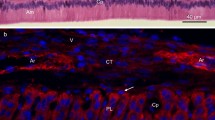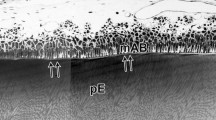Summary
The fine structure of external enamel epithelium, stellate reticulum and stratum intermedium in primary tooth germs (bell stage) from four human foetuses was investigated.
Characteristically, the cells of the differentiated external enamel epithelium, stellate reticulum and stratum intermedium exhibit many free ribosomes, few rough endoplasmic reticulum cisterns, well-developed Golgi complexes, many coated and smooth vesicles, often in relation to the cell membranes, and many bundles of tonofilaments. The cells are connected by numerous desmosomes and gap junctions.
A parallel differentiation of stratum intermedium — external enamel epithelium, and the ameloblast layer is demonstrated.
The morphology of the cells of the three layers indicates that these have secretory, transport and supporting functions.
Similar content being viewed by others
References
Elwood, W.K., Bernstein, M.H.: The ultrastructure of the enamel organ related to enamel formation. Am. J. Anat. 122, 73–94 (1968)
Frank, R.M.: Etude ultrastructurale de la dentinogenèse et de l'amélogenèse. Thèse (Strasbourg) 1968
Frank, R.M., Nalbandian, J.: Ultrastructure of amelogenesis. In: Structural and chemical organization of teeth, Vol. 1 (A.E.W. Miles, ed.) pp. 399–466. New York: Academic Press 1967
Kallenbach, E.: Fine structure of stellate reticulum, outer enamel epithelium and stratum intermedium in the enamel organ of the cat. Anat. Rec. 181, 388 (1975)
Laurent, T.C.: II. Ultrastructure and physical-chemical properties of interstitial connective tissue. Pflügers Arch. 336 (Suppl.), 21–42 (1972)
Matthiessen, M.E.: Histochemical studies of the prenatal development of human deciduous teeth. Acta Anat. 55, 201–223 (1963)
Matthiessen, M.E.: Nucleic acid and protein histochemical studies on the prenatal development of human deciduous teeth. Acta Anat. 60, 220–238 (1965)
Matthiessen, M.E.: Enzyme histochemistry of the prenatal development of human deciduous teeth. Acta Anat. 63, 523–544 (1966)
Matthiessen, M.E.: Comparative enzyme histochemical studies on the development of teeth in man, pig, and mouse. Acta Anat. 66, 375–386 (1967)
Matthiessen, M.E., Helin, G.: Acidic glycosaminoglucuronoglycans of human tooth germs. Scand. J. Dent. Res. 81, 174–176 (1973)
Matthiessen, M.E., Møllgård, K.: Cell junctions of the human enamel organ. Z. Zellforsch. 146, 69–81 (1973)
Matthiessen, M.E., Rømert, P.: The secretory ameloblast of the mini-pig foetus. Cell Tissue Res. 169, 179–192 (1976)
Pannese, E.: Observations on the ultrastructure of the enamel organ. I. Stellate reticulum and stratum intermedium. J. Ultrastruct. Res. 4, 372–400 (1960)
Pannese, E.: Observations on the ultrastructure of the enamel organ. III. Internal and external enamel epithelia. J. Ultrastruct. Res. 6, 186–204 (1962)
Rømert, P., Matthiessen, M.E.: Fixation of foetal pig liver for electron microscopy. Anat. Embryol. 147, 243–258 (1975)
Author information
Authors and Affiliations
Rights and permissions
About this article
Cite this article
Matthiessen, M.E., Rømert, P. Ultrastructure of the human enamel organ. Cell Tissue Res. 205, 361–370 (1980). https://doi.org/10.1007/BF00232278
Accepted:
Issue Date:
DOI: https://doi.org/10.1007/BF00232278




